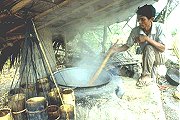

Cambodia 
 |
Wood Energy Situation Policies and Programmes Wood Energy Data Further Reading RWEDP Focal Points |
Wood Energy Situation
Cambodia imports all conventional energy, and has one of the least developed electricity supply networks in the RWEDP region. There are no rural electricity services and the country does not have a transmission network. The country has great hydropower potential, and has oil and gas reserves.
Wood energy is by far the most important energy source, accounting for 84% of total energy consumption in 1994. 96% of households use woodfuels as the major fuel for cooking (94% in Phnom Penh, and 99% in rural areas).
Woodfuels for urban use come mainly from forest areas, which provide 90% of the rural energy supply, and account for almost half of the total woodfuels used in 1995. However, there is no indications to show that this is linked directly to deforestation. The last forest inventory of 1969 showed forest cover to be 73% of the total land area. Present estimates range from 63% to less than 30%. Forest distribution is uneven, with 25% of the country deforested through agricultural conversion, resulting in localised wood shortages.
Policies and Programmes
Energy policy has remained in its draft form since 1995, indicating the reliance on external assistance. The policy focuses on the conventional energy sector, particularly hydropower, and although there is recognition of the ongoing demand for woodfuels, as of yet little consideration has been given to its production, trade and use. The policy states a commitment to undertake fuelwood programmes in conjunction with Ministry of Agriculture, Forestry and Fishery (MAFF) and the Ministry of Industry, Mines and Energy (MIME). The Energy Department of MIME has recently established a wood energy section. However, it also notes that several years of training will be necessary to enable the department to function effectively.
Since 1985, 2,000 ha have been planted by the Department of Forests (DOF). The programme aims to grow industrial wood quickly on degraded sites, but this has been largely unsuccessful due to poor site conditions, neglect and theft. Afforestation programmes currently cover 700 ha/year. Rural people understand the important functions of forests and relate poor soil quality, flooding and drought to their loss, and are therefore keen to protect remaining forest.
Current projects within the DOF include a forest policy review, the monitoring of logging, a forest inventory, and a review of the management of concessions. They are funded and supported by the World Bank and FAO.
The Royal Government of Cambodia states an intention to ensure that "short-term benefits in maximising the area of concessions are not at the expense of longer term benefits nor that of securing the most favourable terms and conditions from a national point of view". The Strategic Plan of MAFF (1996) includes a programme to manage 10.5 million hectares of dry forest and 0.75 million hectares of flooded and mangrove forests. Wood energy is addressed only at rural local level to achieve "some capacity to meet fuelwood needs from community and farm lots". A forest code has been accepted by the government but has not yet been implemented.
Wood Energy Data
| General | |||||
| Population (1996) | 10.3 mln. | ||||
| Share of Rural Population | 78.5% | ||||
| GDP per capita (1993) in constant 1987 US$ | 384 | ||||
| Energy Consumption (1995) | |||||
| Total Final Energy Consumption in PJ | 94.6 | ||||
| Consumption of Wood Energy in PJ | 78.8 | (83.3%) | |||
| Consumption of Biomass Energy in PJ | 80.5 | (85.1%) | |||
| Wood Energy Resources | |||||
| Forest Area (1995) in 1000 ha | 9,830 | (55.7%) | |||
| Natural Forest Area (1995) in 1000 ha | 9,823 | (55.6%) | |||
| Agricultural Area (1994) in 1000 ha | 5,319 | (30.1%) | |||
| Share of Woodfuels from Forest Areas | NA | ||||
| Potential Wood Energy Supply (1994) | |||||
| Sust. Supply from Natural Forest in kton | 13,869 | ||||
| Sust. Supply from Forest Plantations in kton | 160 | ||||
| Sust. Supply from Agriculture Areas in kton | 3,394 | ||||
| Sust. Supply from Other Wooded Land in kton | 831 | ||||
| Supply from Wood Waste from Deforestation in kton | 63,311 | ||||
| Total Potential Supply in kton | 81,565 | ||||
| Primary Wood Energy Requirements in kton | 5,375 | ||||
Notes:
Population and land use data from FAO (FAOSTAT), GDP per capita from World Bank. Energy consumption data from various sources.
Potential wood energy supply estimated by RWEDP, based on available data for land use, wood productivity and estimates on availability of wood for energy use. For forest land, other wooded land and agriculture areas, the potential supply is based on average annual yield estimates, assuming a sustainable use of resources (Sust.: sustainable). Wood waste from deforestation refers to wood potentially available from natural forest land cleared due to commercial logging, expansion of agriculture land or other reasons. The estimates are based on aggregated national data, which can hide local variations, ranging from scarcity to abundance. For detailed calculations and estimates for 2010, see FD50, chapter 8
Further reading:
| Regional Study on Wood Energy Today and Tomorrow in Asia, Field Documents No. 50, 1997 | |
| Chapter 4 in Review of Wood Energy Data in RWEDP Member Countries, Field Documents No. 47, 1997 |
RWEDP Focal Points in Cambodia
Focal points are the main contacts for RWEDP in a member country. Generally, in each country, there is one focal point in the energy sector, and one in the forestry sector.
| Chief Community Forestry Division Reforestation Office Department of Forests and Wildlife 40# Norodom Blvd., Phnom Penh TEL/FAX: 855-23-360661 | Secretary of State Ministry of Industry, Mines and Energy Preah Norodom Blvd., Khan Daun Penh, Phnom Penh TEL/FAX: 855-23-427840 |
Comments, questions? webmaster@rwedp.org
© FAO-RWEDP, 1999